Position the pot in a location that receives partial to full sunlight, depending on the variety of mint you are growing. Most mint varieties prefer at least 4 to 6 hours of sunlight per day.
5. Optimal Watering Techniques for Mint in Pots
Mint requires consistent moisture to thrive, but overwatering can lead to root rot. The key is to maintain a balance by watering the plant when the top inch of soil feels dry to the touch. During hot weather, you may need to water more frequently, while in cooler conditions, less frequent watering is necessary.
Water the plant at the base, avoiding wetting the leaves to reduce the risk of fungal diseases. Ensure that excess water drains freely from the pot, and never allow the plant to sit in standing water. Using a saucer under the pot can help catch excess water, but be sure to empty it regularly.
6. Ensuring Adequate Sunlight and Temperature
Mint plants thrive in full to partial sunlight, depending on the variety. Most mint varieties prefer at least 4 to 6 hours of direct sunlight per day. If you’re growing mint indoors, place the pot near a south-facing window or under grow lights to provide sufficient light.
Mint is a hardy plant that can tolerate a range of temperatures, but it grows best in temperatures between 60°F and 70°F (15°C to 21°C). Protect the plant from extreme heat by providing shade during the hottest part of the day and from frost by bringing it indoors or covering it during cold snaps.
7. Pruning and Harvesting for Maximum Growth
Regular pruning is essential for maintaining a healthy and bushy mint plant. Begin pruning when the plant reaches about 6 inches in height. Use clean, sharp scissors to trim the stems just above a set of leaves. This encourages the plant to branch out and become bushier.
Harvest mint leaves regularly to promote new growth. The best time to harvest is in the morning when the essential oils are most concentrated. Avoid removing more than one-third of the plant at a time to prevent stress and ensure continued growth.
8. Fertilizing Tips to Boost Mint Growth
Mint is a relatively low-maintenance plant, but occasional fertilization can help boost its growth. Use a balanced, water-soluble fertilizer diluted to half strength every 4 to 6 weeks during the growing season. Avoid over-fertilizing, as this can lead to excessive leaf growth at the expense of flavor.
Incorporating organic matter, such as compost or well-rotted manure, into the soil mix at the time of planting can also provide a steady supply of nutrients. This organic approach not only feeds the plant but also improves soil structure and health.
9. Managing Pests and Diseases in Potted Mint
Mint is generally resistant to pests and diseases, but it can occasionally fall victim to common issues such as aphids, spider mites, and powdery mildew. To prevent infestations, regularly inspect your plant for signs of pests and remove any affected leaves.
If pests are present, use a gentle insecticidal soap or neem oil spray to control the population. For fungal diseases like powdery mildew, ensure good air circulation around the plant and avoid overhead watering. Removing affected leaves and applying a fungicidal spray can help manage outbreaks.
10. Overwintering Your Mint Bush Successfully
Mint is a perennial plant that can survive winter with proper care. If you live in a region with mild winters, you can leave the pot outdoors, but consider moving it to a sheltered location to protect it from harsh winds and frost.
In colder climates, bring the pot indoors before the first frost. Place it in a cool, bright location and reduce watering to allow the plant to enter dormancy. In spring, gradually reintroduce the plant to outdoor conditions and resume regular care to encourage new growth.
11. Viral Hacks for Growing a Lush Mint Bush
To maximize your mint bush’s growth, consider using a few viral gardening hacks. One popular method is to use coffee grounds as a natural fertilizer. The grounds add nitrogen to the soil, which can boost leaf growth. Sprinkle a thin layer around the base of the plant every few weeks.Another hack is to use banana peels to enrich the soil with potassium. Bury small pieces of banana peel in the soil around the plant to provide a slow-release source of nutrients. Finally, consider companion planting with other herbs like basil or oregano to enhance growth and deter pests naturally.

Grow the largest mint bush in a pot with this step-by-step guide
ADVERTISEMENT
For Complete Cooking STEPS Please Head On Over To Next Page Or Open button (>) and don’t forget to SHARE with your Facebook friends
ADVERTISEMENT